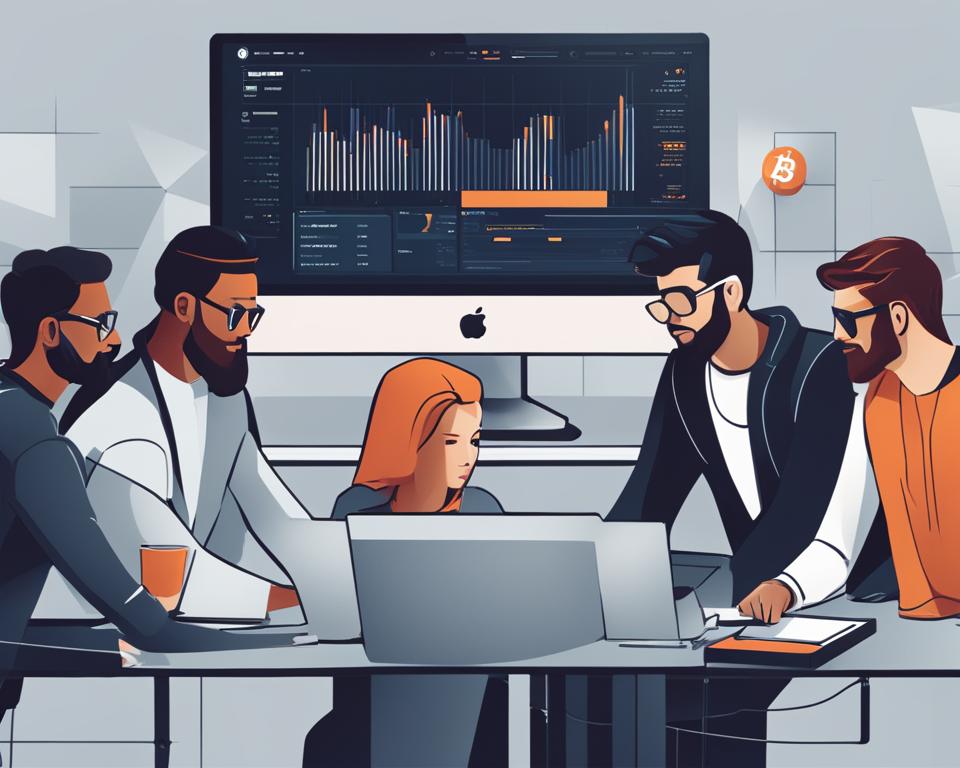Adverts
A blockchain technology it is revolutionizing the financial sector It is various fields at the Brazil. It is a shared, immutable ledger that facilitates the process of recording transactions and tracking assets across a business network. Its importance is due to the fact that it provides immediate, shared and transparent information, stored in an immutable record book.
A Blockchain it can be used to track and trade tangible and intangible assets, offering greater confidence and efficiency. Furthermore, it creates new opportunities for several areas, including the financial sector in Brazil.
Adverts
Main points covered in this article:
- Explanation of blockchain technology
- Main elements of a blockchain
- Operation from the blockchain
- Relationship between Bitcoin and blockchain
- applications from the blockchain technology in different sectors
Main elements of a blockchain
The main ones elements of a blockchain are distributed ledger technology, immutable ledgers, and smart contracts.
Distributed ledger technology allows all network participants to have access to the distributed ledger and its immutable record of transactions.
Adverts
Immutable records ensure that no one can alter or corrupt a transaction once it is entered into the ledger.
Smart contracts are sets of rules stored on the blockchain that are automatically executed during transactions.
| Blockchain elements | Description |
|---|---|
| Distributed ledger technology | Allows all participants to have access to the shared transaction record. |
| Immutable records | They ensure that transactions are permanent and tamper-proof. |
| Smart Contracts | These are rules automatically executed during transactions on the blockchain. |
Those elements are essential for the operation and the unique characteristics of blockchain. Distributed ledger technology enables decentralization and transparency in transactions, while immutable ledgers ensure data security and integrity. Smart contracts automate the execution of operations and the application of predefined rules.
Combined, these elements form a revolutionary technology that is impacting several sectors, offering reliable, secure and transparent solutions for transactions.
How blockchain works
Blockchain works by recording each transaction as a block of data. These blocks are connected to a previous and a subsequent block, forming a data chain.
Transactions are included in an irreversible chain, strengthening verification of each block and the entire chain. In this way, blockchain offers immutability and eliminates the possibility of tampering by a malicious individual.
Blockchain components:
- Transactions: Transactions are the information that will be recorded on the blockchain, such as the transfer of digital assets.
- Blocks: Blocks are sets of transactions that are grouped together and added to the existing blockchain.
- Hash: The hash is a unique sequence of characters generated from the data contained in a block. It serves to identify and verify the integrity of the block.
- Miners: Miners are responsible for validating transactions and adding new blocks to the chain. They compete to solve complex mathematical problems that require computational power and are rewarded with cryptocurrencies such as Bitcoin.
The use of blockchain technology provides security, transparency and reliability in transactions, in addition to eliminating the need for intermediaries. This happens due to the collective and decentralized verification carried out by network participants. In this way, blockchain is revolutionizing several sectors, such as finance, logistics, healthcare and many others.
O operation of blockchain can be summarized in one sentence: a distributed and immutable ledger that guarantees the integrity and security of transactions.
Bitcoin and blockchain
Although Bitcoin and blockchain are often used interchangeably, they are distinct things. Bitcoin is a digital currency that operates without centralized control, while blockchain is the technology that underpins Bitcoin and enables its transactions.
However, blockchain has several applications in addition to Bitcoin, being used in various sectors, such as finance, health, logistics, among others. Blockchain technology offers a secure system for recording, verifying and executing transactions, without the need for intermediaries.
By using blockchain, it is possible to track the origin and authenticity of assets, ensure transparency in audit processes and simplify bureaucratic procedures. The technology also makes it possible to create smart contracts, which are programmed to automatically perform specific actions when certain conditions are met.
In the financial area, for example, blockchain allows for more efficient and secure transactions, eliminating the need for intermediaries such as banks and notary offices. Additionally, technology offers greater access to financial services, especially for people without access to traditional banking infrastructure.
In the healthcare sector, blockchain can be used to store and share medical records securely and reliably, streamlining the care process and improving interoperability between healthcare institutions.
In logistics, blockchain can bring greater visibility and traceability throughout the supply chain, allowing precise monitoring of the origin, transport and delivery of goods.
In short, blockchain goes beyond Bitcoin and has disruptive potential in several areas. Its ability to offer transparency, security and decentralization makes it a promising technology for applications in different sectors.
| Sector | Blockchain Applications |
|---|---|
| Finance | Secure and efficient transactions, access to financial services, smart contracts |
| Health | Secure storage of medical records, interoperability between institutions |
| Logistics | Supply chain traceability and visibility |
What is Blockchain?
Blockchain can be defined as a block chain, which groups a set of information connected through encryption. It is important to ensure the security and integrity of transactions, and works like a large public ledger, in which all transactions are recorded. Blockchain allows transactions to be carried out securely, making each currency traceable from the moment of its creation.
Blockchain is an innovative technology that is revolutionizing different sectors in the world. Brazil and in the world. It offers solutions to trust and security issues, creating an environment conducive to new business opportunities.
The blockchain is like a large public ledger, immutable and decentralized, which records all transactions in a transparent and secure way.
This distributed ledger ensures that all parties involved have access to the same information and avoids the need for intermediaries to validate transactions. Furthermore, blockchain uses cryptography to protect data and guarantee its integrity.
With blockchain, each transaction carried out is grouped into a block and connected to other previous and subsequent blocks, forming a chain of blocks. This structure guarantees the security and reliability of transactions, making blockchain an ideal technology for various applications.
Main features of blockchain:
- Decentralization: there is no central entity controlling the network, making it more secure and resistant to attacks.
- Transparency: all transactions are publicly recorded and can be audited in real time.
- Immutability: Once a transaction is recorded on the blockchain, it becomes permanent and cannot be changed or reversed.
Blockchain technology is transforming several sectors, from finance to healthcare and logistics. It offers solutions to problems such as fraud, lack of transparency and unnecessary intermediaries, providing greater efficiency and security in transactions.
How does Blockchain work?
Blockchain is a technology that orders blocks of information in a sequential chain, ensuring the security and reliability of transactions. Each block contains essential data, such as the date and time it was mined, the amount transacted, parts of the transaction and unique hashes.
Miners play a fundamental role in the process, being responsible for finding solutions (hashes) that connect blocks and validate transactions. After mining a block, users of the Bitcoin network check the answer provided by miners and decide which sequence of blocks to follow, opting for the longest and most reliable chain.
See below for a visual representation of how it works the Blockchain:

| Blockchain Components | Operation |
|---|---|
| Date and time | Records the date and time the block was mined, creating a sequential history of transactions. |
| Quantity Transacted | Records the amount of value transacted in each block, ensuring transparency in financial transactions. |
| Parties to the Transaction | Records the parties involved in each transaction, allowing verification and traceability of operations. |
| Unique Hashes | It uses cryptographic hashes to interconnect blocks, making it impossible to change past data and maintaining the integrity of the chain. |
Through this process, Blockchain guarantees the security of transactions by eliminating dependence on a central authority. Additionally, the immutability of records provides an additional layer of reliability, making Blockchain a promising technology for diverse industries such as finance, supply chain, healthcare, and more.
Advantages of Blockchain Technology:
- Decentralization: Eliminates the need for a central entity to coordinate transactions, making the network more secure and resistant to attacks.
- Transparency and Free Access: All transactions are auditable in real time, ensuring data integrity and fostering trust.
- Immutability: Transactions recorded on the Blockchain are permanent and cannot be altered or reversed, ensuring the reliability of operations.
Advantages of Blockchain Technology
Blockchain technology has several benefits which make it an innovative and revolutionary solution in different sectors.
Decentralization
One of the main benefits of Blockchain is decentralization. Unlike traditional systems, there is no central entity coordinating the entire process. Instead, Blockchain is distributed across a network of nodes (computers) that store and validate transactions. This decentralization makes the network more secure and resistant to attacks, as there is no single vulnerable point that can be compromised.
Transparency and Free Access
Blockchain provides transparency and free access to all transactions carried out on the network. All transactions are recorded in real time and can be audited by any network participant. This ensures data integrity and promotes trust between those involved. Any change or attempted fraud would be immediately identified and rejected by the network.
Immutability
Immutability is another fundamental advantage of Blockchain. Once transactions are recorded in a data block and added to the chain, they become permanent and cannot be changed or reversed. This ensures the integrity of transactions and helps prevent fraud or subsequent manipulation.
Decentralization, transparency and free access, along with immutability, are essential characteristics of Blockchain technology. These benefits make this technology increasingly relevant in various sectors, such as finance, healthcare, logistics and much more.
Next, discover how Blockchain is applied to Bitcoin and better understand how this revolutionary technology works.
Blockchain technology offers several advantages such as decentralization, transparency and immutability. These characteristics make Blockchain a secure, reliable and transparent solution for transactions in different sectors.

Conclusion
Blockchain technology is driving a real technological revolution in different sectors in Brazil and around the world. With its ability to provide security, reliability and transparency for transactions, blockchain is transforming the way business activities are conducted.
Furthermore, blockchain opens up new business opportunities and enables innovative approaches to complex problems. With its basis in Web 3.0, blockchain seeks to decentralize power over data, returning it to users and making the internet more democratic and inclusive.
The financial industry is one of the sectors benefiting most from blockchain technology, offering secure and efficient solutions for money transfers, property records and smart contracts. However, the blockchain revolution is not limited to the financial sector. It has the potential to transform areas such as healthcare, logistics, governance, among others, optimizing processes, reducing costs and increasing reliability.
With all these advantages and its potential for transformation, blockchain technology promises to be the basis of this technological revolution in Brazil. As more companies and institutions adopt blockchain, significant changes are expected to occur in the way business is conducted and how digital interactions are carried out.
FAQ
What is Blockchain technology?
Blockchain technology is a shared, immutable ledger that facilitates the process of recording transactions and tracking assets across a business network.
Why is Blockchain technology important?
Blockchain technology is important because it provides immediate, shared and transparent information stored in an immutable ledger. Furthermore, it offers greater confidence and efficiency, as well as new opportunities for several areas, including the financial sector, in Brazil.
What are the main elements of a blockchain?
The main elements of a blockchain are distributed ledger technology, immutable records, and smart contracts.
How does blockchain work?
Blockchain works by recording each transaction as a block of data. These blocks are connected to a previous and a subsequent block, forming a data chain. Transactions are included in an irreversible chain, strengthening verification of each block and the entire chain.
What is the relationship between Bitcoin and blockchain?
Although Bitcoin and blockchain are often used interchangeably, they are distinct things. Bitcoin is a digital currency that operates without centralized control, while blockchain is the technology that underpins Bitcoin and enables its transactions. However, blockchain has several applications beyond Bitcoin, being used in various sectors, such as finance, health, logistics, among others.
What is Blockchain?
Blockchain can be defined as a block chain, which groups a set of information connected through encryption. It is important to ensure the security and integrity of transactions.
How does Blockchain work?
Blockchain orders blocks of information in a sequential chain. Miners are responsible for finding solutions (hashes) that connect blocks and validate transactions. Bitcoin network users check the answer provided by miners and decide the longest sequence of blocks to follow. In this way, Blockchain guarantees the security and reliability of transactions.
What are the advantages of Blockchain technology?
Blockchain technology has several advantages, such as decentralization, transparency and free access, and immutability.


